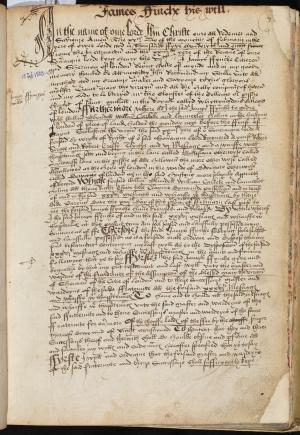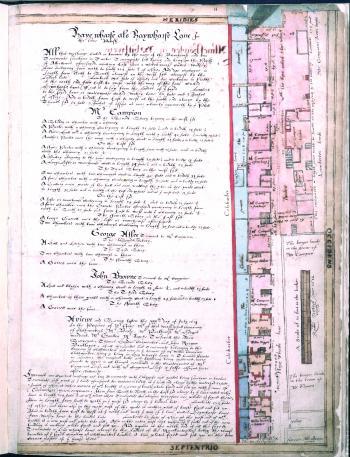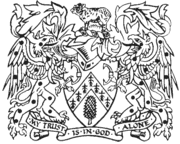 James Finch bequeathed thirty-six messuages and a wharf at Haywharf Lane, Upper Thames Street to the Shearman’s Company, by his will of 15 February 1508.[1] The properties passed to The Clothworkers’ Company on the amalgamation of the Fullers and Shearmen companies in 1528. Under the terms of his bequest, Finch instructed the Company to find and sustain a Doctor or Bachelor of Divinity at Whittington College of London, who would read divinity within the college three days a week.[2]
James Finch bequeathed thirty-six messuages and a wharf at Haywharf Lane, Upper Thames Street to the Shearman’s Company, by his will of 15 February 1508.[1] The properties passed to The Clothworkers’ Company on the amalgamation of the Fullers and Shearmen companies in 1528. Under the terms of his bequest, Finch instructed the Company to find and sustain a Doctor or Bachelor of Divinity at Whittington College of London, who would read divinity within the college three days a week.[2]
The first reference to the properties in the Company Court Orders came in April 1552, when they granted a lease of eight tenements to Robert Mekylfield for thirty years.[3] On the same day, the Company issued a warning to two of their tenants, Mr. Campion, Master and Mrs. Gates to ‘clean the common lane on the back side’ of their tenements.[4] The Company surveyed the properties extensively as part of their annual viewing. In 1554, for example, they issued strict instructions for the improvement of the wharf and tenements.[5] The Court Orders recorded these as:
‘The hay loft and stable standing on the wharf to be taken down and new built again according to a convenant expressed in the lease. The back lane of the tenements is filthy and needs to be cleansed by Mr. Campion who enjoys the tenements’.[6] In the aftermath of these poor reports, the Company ordered ‘ that the olde house at heywharffe shalbe taken downe betwene this & marche next commynge And that Mrs gates wedowe shall have warnynge to newe make & set vpp a fframe there accordynge to the tenor of her lease’.[7] Despite the attempts at improvements, the Court Orders noted further problems in January 1556. Surveyors noted that the wharf was very decayed with both stones missing and timbers rotten.[8] Further issues related to the stables and hay loft on top of the wharf, which had also rotted. Even the tenements were criticised as being in ‘sore decaye’.[9] The cellars were also described as being full of water and rubbish.[10]
The annual survey recorded problems with the Haywharf Lane in the late sixteenth century. In 1570, for example, the Court Orders noted that the surveyors complained ‘the walls of stone, on the bak lane syde, [were] broken, and also there [was] a synke to be amended’.[11] Little had been done to rectify the on-running problems on the Lane when the surveyors examined the tenements in their 1577 survey. In this year, the tenement in the tenure of a Mr. Hall lacked tiling.[12] Despite these problems, the Company continued the day-to-day management of the properties. In 1579, the Company issued a lease of eight tenements to Henry Campion for eighty years.[13] Campion undertook to pay £10 5s. rent a year and pay £100 as a fine.[14] By 1581, an Abraham Campion had also received a lease for multiple tenements on Haywharf Lane.[15] Abraham’s lease was for a forty year term, and he agreed to pay £12 rent annually and £100 as a fine.[16] The Company added the additional clause that he was to be responsible for all repairs to the tenements.[17]
In 1585, the Court Orders noted problems relating to Abraham Campion’s tenements, which were described as reeling forwards.[18] In 1595, Abraham Campion was back at Court to receive a new lease of his tenements, presumably because he repaired the problems with the tenements in the intervening years. At this point the Company offered Abraham another fourteen years on his lease, which would bring his total back up to a forty year lease.[19] Abraham Campion remained a central figure in the Company’s management of their Haywharf Lane property portfolio. In July 1609, they made an agreement with Campion that he would ‘become bound to the Master of the company to the sum of £500 that if at any time the corner tenement in Thames Street belonging to the merchant tailors scituate at the upper end and on the other side of a certain lane called haywharfe Lane shall at any time make any just or lawful claim challenge or demand of or to a passage or walk from the said tenement to the wharfe called Heywharfe to take up and goods that then the said Abraham and assignes shall quietly permit and suffer the said tenant to do so’.[20]
Treswell captured the Haywharf Lane properties in his 1612 survey. He described the tenements held by William Campion in 1612 in great detail noting that  they comprised a ‘one capitall messuage and two Tenements with the wharfe and yardes being sometyme in twelue Tenements and parcell of the lands’.[21] This area included a brew house, which made the layout of the properties more unusual than many of their contemporaries. The tenements held by Campion were generally four storeys in height.[22] George Atlee, a tenant of Mr. Campion, held a tenement which comprised his shop on the ground floor; a hall and kitchen with two chimneys on the second floor; two chambers with two chimneys on the third storey and a garret on the fourth storey.[23] Following Treswell’s survey, the Company erected six brass plates on their tenements in Haywharf Lane, which bore the inscription ‘Clothworker’ on them.[24]
they comprised a ‘one capitall messuage and two Tenements with the wharfe and yardes being sometyme in twelue Tenements and parcell of the lands’.[21] This area included a brew house, which made the layout of the properties more unusual than many of their contemporaries. The tenements held by Campion were generally four storeys in height.[22] George Atlee, a tenant of Mr. Campion, held a tenement which comprised his shop on the ground floor; a hall and kitchen with two chimneys on the second floor; two chambers with two chimneys on the third storey and a garret on the fourth storey.[23] Following Treswell’s survey, the Company erected six brass plates on their tenements in Haywharf Lane, which bore the inscription ‘Clothworker’ on them.[24]
Throughout the 1620s, 1630s and 1640s, leases for the properties at Haywharf Lane continued to be dominated by the Campion family. In 1651, the Court Orders recorded a petition by Campion for a new lease of certain houses at Haywharf Lane.[25] The Company agreed to grant the new lease and undertook to bear the cost of repairs to the houses.[26] The Haywharf Lane properties were destroyed during the Great Fire of London. In its aftermath, the Company reached an agreement with Campion to surrender two leases to the Company. In May 1668, they granted a lease to Mr. Hammond of the properties, which included the brew house ground.[27] Hammond undertook to pay £32 rent a year and a £250 fine. He also agreed to pay £50 towards the rebuilding of the Company Hall and to pay all arrears of rents and taxes.[28] Over the ensuing years, Hammond came to Court to seek an addition of years to his lease agreement due to the monies he had spent on rebuilding the properties at Haywharf Lane. In 1681, the Company granted him an additional five years, which granted Hammond a sixty-six year lease term.[29]
The Company retained the Haywharf Lane properties until the nineteenth century, by which time they had been integrated as part of 80, Upper Thames Street. The property was sold in 1877.[30] The Haywharf Lane properties were noted extensively in the Company accounts. Taken at twenty year intervals the monies accrued from the property can be noted. In 1600, the Company received a rental income of £32.[31] In the same year, the Company spent £14 4s. on Haywharf Lane related expenditure.[32] In 1620, the annual rental income from Haywharf Lane was £32, while the expenditure was £14 14s.[33] In 1640, the annual income from Haywharf Lane was £32, with expenditure of £14 14s. 6d.[34] By 1660, the annual income was £32 with expenditure reaching £18 1s.[35] By 1680, the Company was receiving c.£32 annually from the Haywharf Lane properties, with expenditure of c.£14 13s.[36]
Individuals associated with this property
- - Campion, Late occupier, 26-5-1584. Document reference: CL/b/1/3/f. 39v
- - Campion, Leaseholder, 19-2-1583. Document reference: CL/b/1/3/f. 20v
- - Campion, Leaseholder, 31-1-1587. Document reference: CL/b/1/3/f. 71r
- - Campion, Leaseholder, 8-6-1607. Document reference: CL/b/1/5/f. 8v (Houses, wharf and tenements, Haywharfe Lane)
- - Campion, Leaseholder, 2-8-1608. Document reference: CL/b/1/5/f. 29v (Eight tenements and a wharf, Haywharfe Lane)
- - Campion, Leaseholder, 8-5-1613. Document reference: CL/b/1/5/f. 146r
- - Campion, Lease taker, 16-11-1579. Document reference: CL/b/1/2/f. 235v
- - Campion, Lease taker, 15-6-1587. Document reference: CL/b/1/3/f. 74r
- - Campion, Lease taker, 2-8-1608. Document reference: CL/b/1/5/f. 29v (Eight tenements and a wharf, Haywharfe Lane)
- - Campion, Suitor, 23-3-1579. Document reference: CL/b/1/2/f. 227r
- - Campion, Suitor, 16-11-1579. Document reference: CL/b/1/2/f. 235v
- Abraham Campion, Leaseholder, 22-7-1608. Document reference: CL/b/1/5/f. 28r-28v (Eight tenements, Haywharf Lane)
- Abraham Campion, Leaseholder, 25-7-1609. Document reference: CL/b/1/5/f. 47v (The corner tenement in Thames Street belonging to the merchant tailors situated at the upper end and on the other side of Haywharf Lane)
- Abraham Campion, Suitor, 2-7-1600. Document reference: CL/b/1/3/f. 196r-196v
- - Campion, Lease taker, 16-11-1579. Document reference: CL/b/1/2/f. 235v
- Henry Campion, Late occupier, 2-7-1600. Document reference: CL/b/1/3/f. 196r-196v
- Henry Campion, Leaseholder, 29-3-1574. Document reference: CL/b/1/2/f. 180v-181r
- William Campion, Leaseholder, 30-7-1613. Document reference: CL/b/1/5/f. 153r
- - Hall, Late occupier, 10-10-1581. Document reference: CL/b/1/3/f. 3r
- - Hall, Late occupier, 14-1-1589. Document reference: CL/b/1/2/f. 225r (Haywharfe Lane)
- John Hall, Leaseholder, 24-11-1579. Document reference: CL/b/1/2/f. 235v
- Richard Hammond, Leaseholder, 14-6-1681. Document reference: CL/b/1/10/p. 570
- - Hamond, Leaseholder, 11-11-1668. Document reference: CL/b/1/10/p. 148
- John Haull, Leaseholder, 29-3-1574. Document reference: CL/b/1/2/f. 180v-181r
- - Meckylfelde, Late occupier, 12-12-1581. Document reference: CL/b/1/3/f. 6v
- - Parkinson, Lease taker, 14-1-1589. Document reference: CL/b/1/2/f. 225r (Haywharfe Lane)
- Bartholomew Quyney, Suitor, 5-9-1581. Document reference: CL/b/1/3/f. 2v
- Thomas Wright, Late occupier, 19-2-1583. Document reference: CL/b/1/3/f. 20v
- Thomas Wright, Leaseholder, 26-5-1584. Document reference: CL/b/1/3/f. 39v
[1] 'Report on the Charities of the Clothworkers' Company: Part I', City of London Livery Companies Commission. Report; Volume 4 (1884), pp. 572-599. URL: http://www.british-history.ac.uk/report.aspx?compid=69737 Date accessed: 28 October 2010.
[2] Ibid.
[3] The Clothworkers’ Company Archive (hereafter CCA), Court Orders, CL/B/1/1, f. 178r, Lease to Robert Mekylfield, 6 April 1552.
[4] CCA, Court Orders, CL/B/1/1, f. 178r, Warning to Campion and Gates, 6 April 1552.
[5] CCA, Court Orders, CL/B/1/1, ff 195v-196r, Survey of the Haywharf Lane properties, 6 June 1554.
[6]Ibid.
[7] CCA, Court Orders, CL/B/1/1, f. 195r, Rebuilding at Haywharf, 30 May 1554.
[8] CCA, Court Orders, CL/B/1/1, ff 211r-211v, Survey of the Haywharf Lane properties held by Mrs. Gates, 8 January 1556.
[9] Ibid.
[10] Ibid.
[11] CCA, Court Orders, CL/B/1/2, f. 140v, Survey at Haywharf Lane, 20 April 1570.
[12] CCA, Court Orders, CL/B/1/2, ff 215v-216r, Survey at Haywharf Lane, 11 March 1577.
[13] CCA, Court Orders, CL/B/1/2, f. 231r, Lease to Henry Campion, 12 May 1579.
[14] Ibid.
[15] CCA, Court Orders, CL/B/1/3, f. 3r, Lease to Abraham Campion, 10 October 1581.
[16] Ibid.
[17] Ibid.
[18] CCA, Court Orders, CL/B/1/3, ff 45v-47r, Survey of Abraham Campion’s tenements, 22 March 1585.
[19] CCA, Court Orders, CL/B/1/3, f. 145v, New lease to Abraham Campion, 13 July 1595.
[20] CCA, Court Orders, CL/B/1/5, f. 47v, Agreement with Abraham Campion, 25 July 1609.
[21] CCA, Treswell Survey, 1612
[22] Ibid.
[23] Ibid.
[24] CCA, Court Orders, CL/B/1/5, f. 153r, Brass plates to be erected on the properties at Haywharf Lane, 30 July 1613.
[25] CCA, Court Orders, CL/B/1/9, f. 17r, Suit by Campion for a new lease of houses at Haywharf Lane, 24 October 1651.
[26] Ibid.
[27] CCA, Court Orders, CL/B/1/10, p. 99, Lease to Hammond, 18 May 1668.
[29] CCA, Court Orders, CL/B/1/10, p. 570, Addition of years to Hammond’s lease, 14 June 1681.
[30] A. Buchanan, ‘The Sources of the Wealth of The Clothworkers’ Company’, unpublished paper.
[31] CCA, Renter Warden Accounts, CL/D/5/4, Section 6, The Renter Warden accounts of Anthony Fawlkes, 1600, f. 1r
[32] CCA, Renter Warden Accounts, CL/D/5/4, Section 6, The Renter Warden accounts of Anthony Fawlkes, 1600, f. 3ar.
[33] CCA, Renter Warden Accounts, CL/D/5/5, Section 16, The Renter Warden accounts of Daniel Hall, 1620, f. 2r and 6r.
[34] CCA, Renter Warden Accounts, CL/D/5/8, Section 4, The Renter Warden accounts of William Harris, 1640, f. 3r and 8v.
[35] CCA, Renter Warden Accounts, CL/D/5/10, The Renter Warden accounts of Dennis Gawden, 1660, f. 5 and ff 14-15.
[36] CCA, Renter Warden Accounts, CL/D/5/12, The Renter Warden accounts of Robert Stevenson, 1680, f. 5 and f. 12. The income figures cannot be accurately calculated due to damage to the originals.
